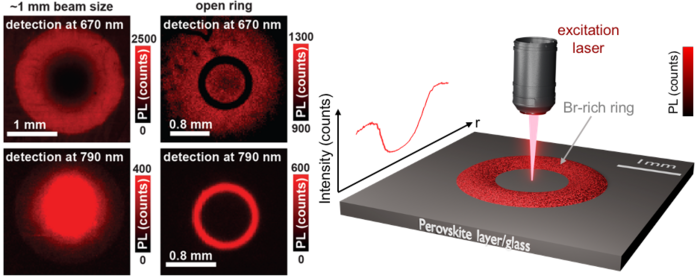Lead halide perovskites (such as MAPbI3), a new class of semiconductor materials, have exceptional optoelectronic properties that make them suitable for photovoltaic and light-emitting applications.
 PL emission mapping of MA0.17FA0.83Pb(I0.5Br0.5)3 at the detection wavelength of 670 nm and 790 nm after local illumination for 1 h with a beam size of ~ 1 mm and density of 1 sun on the bare film, and over an annular aperture with a 1 mm diameter pinhole and a center obstruction target of 850 µm, respectively. Image Credit: Xiaoxiao Sun, Yong Zhang, Weikun Ge
PL emission mapping of MA0.17FA0.83Pb(I0.5Br0.5)3 at the detection wavelength of 670 nm and 790 nm after local illumination for 1 h with a beam size of ~ 1 mm and density of 1 sun on the bare film, and over an annular aperture with a 1 mm diameter pinhole and a center obstruction target of 850 µm, respectively. Image Credit: Xiaoxiao Sun, Yong Zhang, Weikun Ge
One of the primary causes generating abnormal I-V hysteresis and poor stability in the perovskite solar cells has been reported in these materials, and it is significant ion migration. Mainly, photoinduced halide anion “segregation” is seen in mixed halide perovskites, and it is reversible when the illumination is turned off.
The segregation issue negatively affects optoelectronic applications and must be resolved. The red shift in the photoluminescence (PL) peak from the predicted wavelength for the alloy to that with a substantially greater concentration of iodine is the most notable result of the ion segregation.
According to conventional wisdom, a uniform alloy of MAPbI1–xBrx would segregate into domains rich in iodine and domains rich in bromine inside the lighted area. To explain the occurrence, a variety of microscopic mechanisms have been suggested. None of them, however, can clearly explain every salient feature of the phenomenon.
Although it is implicitly assumed that the so-called “Br-rich” and “I-rich” regions are simply Br-rich and I-rich alloys, the chemical and structural features of these regions are not yet completely known.
Researchers from the University of North Carolina at Charlotte, the Swiss Federal Laboratories for Materials Science and Technology, and Tsinghua University in China have discovered that anion segregation in mixed halide alloys is a nonlocal effect, with the possibility of ion redistribution occurring on a macroscopic or mesoscopic scale well beyond the illuminated area on a scale proportional to the illumination.
The generally accepted photo-induced “on-site” anion segregation in mixed halide perovskite alloys is presented in a completely new light by this work, published in Light Science & Application.
The authors stated, “Specifically, we find that under illumination, within the illumination area, the PL peak is red shifted from the initial position; while concurrently, outside the illuminated area, the alloy PL peak is strongly enhanced in a ring area circling the illuminated area.”
“Furthermore, the process is reversible, but non-monotonically, exhibiting ultra-low-frequency damped oscillations between the ring and center in terms of PL intensity and position.”
“These surprising observations can be explained as that free Br ions are expelled from the illuminated area, resulting in a positively charged area, and concomitantly forming a negatively charged Br-rich ring, both being off stoichiometry from the original alloy.”
“This phenomenon can be viewed as an ionic analogy of a mesoscopic PL ring formation away from the illuminated site in GaAs/AlGaAs quantum wells, resulting from the disparity in the electron and hole diffusion lengths and thus their spatial profiles,” further stated the authors.
According to the authors, the strange oscillating behavior might be caused by an ionic plasma or ionic plasmon oscillation that has never been observed in solids. These findings provide new perspectives on the fundamental mechanism of ion segregation in mixed halide alloys, which means it is not necessarily a negative phenomenon to suppress but something potentially useful, such as energy storage.
An encouraging indication is the measurement of a voltage of about 0.4 V between the center and the ring, which suggests that a battery that can be directly charged by light could be possible.
Journal Reference:
Sun, X., et al. (2022) Photo-induced macro/mesoscopic scale ion displacement in mixed-halide perovskites: ring structures and ionic plasma oscillations. Light Science & Application. doi:10.1038/s41377-022-00957-8.